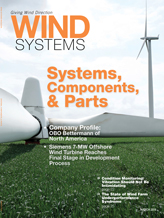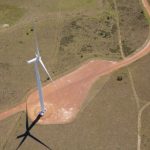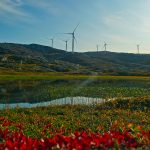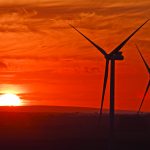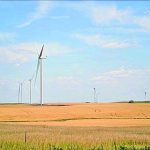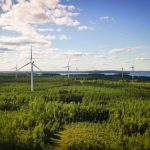Wind energy installed more electric generating capacity last year than any other energy source in America.
The 8.6 GW of wind power capacity installed surpassed the 7.3 GW of new solar photovoltaic capacity and 6 GW installed by natural gas, according to data from the American Wind Energy Association (AWEA) and the recently released Business Council for Sustainable Energy (BCSE) and Bloomberg New Energy and Finance (BNEF) 2016 Factbook. Wind accounted for more than 35 percent of new generating capacity, while all renewable resources together provided 68 percent of the new capacity, according to the factbook.
“Wind’s growth is being propelled by cost reductions of two-thirds over the last six years, which now makes wind the lowest-cost source of new generation,” said Tom Kiernan, CEO of AWEA, at the annual winter meeting of the National Association of Regulatory Utility Commissioners (NARUC) in Washington, D.C. “It’s one of the biggest, fastest, and cheapest ways we can reduce U.S. carbon emissions, and it’s the low-cost solution for power sector reductions. Utilities and other purchasers are turning to wind energy because it provides stably-priced energy with no fuel price risk and protects consumers by creating a more diverse energy portfolio.”
After a strong finish last year, wind energy is off to a good start in 2016 with an additional 9.4 GW under construction, an additional 4.9 GW in advanced stages of development, and a predictable federal production tax credit for the next several years.
“With long-term policy certainty in place, wind power is ready to keep this American success story going,” said Mike Garland, CEO of Pattern Energy and current AWEA board chair. “Further investments in our technology will enable utilities to cut costs and pass on the savings to American homeowners and businesses.”
According to Chris Brown, president of Vestas Americas, these impressive results drive home the point that wind is a cost-effective solution that makes business sense.
“More than 500 wind industry factories in 43 states are turning out taller turbines, longer blades, and other components that capture more energy, helping further drive down our costs and opening up new parts of the country for utility-scale wind farms,” Brown said.
When the U.S. Supreme Court put a temporary stay on certification of state plans under the federal Clean Power Plan, states and utilities continued to develop solutions to reduce carbon pollution from fossil power plants. Many utilities have already indicated that the stay will not affect their planned generation changes. Many recognize that carbon reductions are inevitable, and the Supreme Court has already affirmed in multiple rulings that the EPA has the authority and obligation to regulate greenhouse gas emissions.
In a recent statement in which Xcel Energy said that it plans to invest $6 billion in wind and solar energy, the company also said that while the Supreme Court’s ruling is a significant development in this case, the merits of the case have not been decided and the legal proceedings will continue.
“Xcel’s analysis of the strategy, which speeds up wind and solar investment in this decade, shows it to be a cost-effective way to reduce greenhouse gas emissions by 60 percent by 2030 — likely beyond Minnesota’s requirements under the Clean Power Plan,” said Laura McCarten, regional vice president for Xcel.
After the stay, Xcel said it would continue to work with states and stakeholders on plans “to create sustainable and affordable energy futures… This approach will not only ensure compliance with existing and new regulations, but also take advantage of new technologies, recognize evolving customer needs, and continue to drive improvements in how we produce and deliver energy.” Grid operators such as PJM Interconnection have also indicated that they plan to proceed with planning to accommodate the Clean Power Plan, as have many states.
With wind energy costs at an all-time low and the recent extension of key federal tax incentives for wind and solar, a new analysis using a Department of Energy modeling tool concludes that the tax extenders allow states to meet pending carbon dioxide regulations almost exclusively with zero-emitting renewables.
Zero-emission wind energy also provides states and utilities with more flexible options for reducing pollution, relative to energy sources with some emissions that would require the replacement of far more existing generation to achieve the same level of emissions cuts.
Wind Power Cutting Costs
The rapid growth of renewables and the continued retirement of coal plants have not significantly impacted retail prices, according to BCSE and BNEF’s 2016 Factbook, which reported that retail electricity rates across the country remain 5.8 percent below the recent peak (2008).
Innovations by the wind industry have helped lower wind power’s costs by two-thirds in the last six years, as shown by the Lawrence Berkeley National Laboratory. The Wall Street investment firm Lazard also found a cost decline of more than 60 percent and notes that wind energy is the lowest-cost energy source for reducing emissions, even before tax incentives.
MidAmerican Energy recently obtained approval from the Iowa Utilities Board for the addition of 1,050 MW of wind energy in Iowa, for example. The expansion is planned to be built at no net cost to the company’s customers and will help stabilize electric rates over the long term by providing a rate reduction totaling $10 million per year by 2017 with a $3.3 million reduction in 2015, according to MidAmerican.
When Southern Company’s Alabama Power made its first wind power purchase, it said that the price of energy from the wind facility is expected to be lower than the cost the company would incur to produce that energy from its own resource with the resulting energy savings flowing directly to the company’s customers.
“The levelized cost of energy (LCOE) from wind has fallen dramatically in recent years,” said David Engels, senior manager of operations renewable asset strategy for Alliant Energy and session chair for utility issues during this year’s Windpower event in New Orleans from May 23 to 26. “Increases in overall turbine efficiencies coupled with reduced turbine costs have made wind competitive with alternate sources of generation. Independent power producers and utilities alike continue to evaluate and make investments in their wind portfolios.”
Wind Power Helping Utilities Keep the Lights On
With today’s installed capacity, wind energy produces enough electricity to power more than 19 million U.S. homes.
Iowa, South Dakota, and Kansas all source more than 20 percent of their annual electricity from wind. Wind power already provides a total of nine states with 12 percent or more of their annual electricity production.
The Electric Reliability Council of Texas (ERCOT), the primary grid operator in Texas, has seen wind reliably meet as much as 44.7 percent of its electricity demand at certain points in time, peaking at 13,883 MW in December 2015. Wind supplied 18.4 percent of ERCOT’s total demand for the full month of November 2015 and surpassed nuclear as the third largest source of generation in ERCOT for all of 2015. Wind has supplied as much as 12,720 MW in MISO, the grid operator for parts of 12 Midwest states. Last December, wind production hit 9,948 MW in the Southwest Power Pool (SPP), the grid operator for all or parts of eight states. On the main Colorado grid, wind provided 66.4 percent of the electricity at one point in November 2015. These real-world examples demonstrate how utilities are reliably integrating large amounts of wind energy today.
However, barriers remain to spreading wind energy’s low-cost benefits to all corners of the country. Access to sufficient transmission infrastructure will be an important catalyst for future growth of wind energy. Analyses by grid operators SPP and MISO confirm that transmission provides billions of dollars in net benefits to consumers by reducing costs and improving reliability, by gaining access to America’s best wind resources.
The Department of Energy’s (DOE) Wind Vision report shows a path for wind power to double in the next five years and supply 20 percent of U.S. electricity needs by 2030, creating tremendous economic and environmental benefits along the way. Consumer savings from wind are projected to reach $14 billion a year by 2050, with cumulative savings on electricity bills reaching $149 billion.
2015 ranks as the third highest year for wind installations on record. American wind power has installed as much as 13,124 MW in a single year (2012) when wind also was the largest source of new electrical generating capacity as it was last year.
— Source: AWEA
For more information,
go to www.awea.org.
















